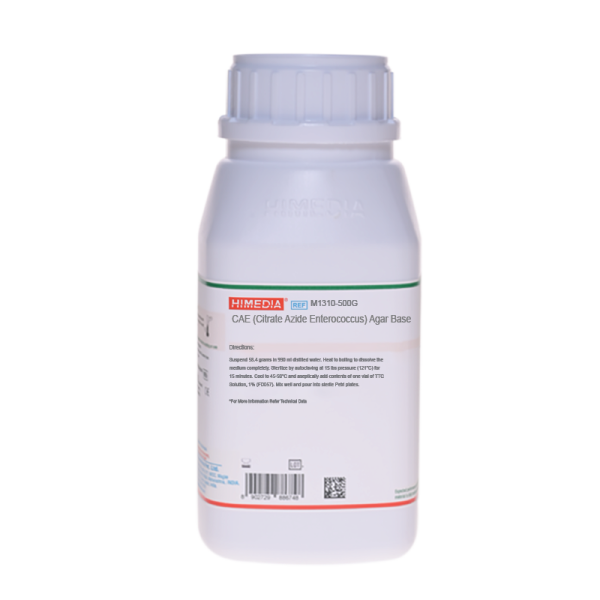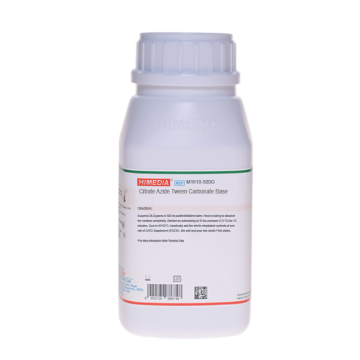 Your enquiry has been submitted
Your enquiry has been submitted
CAE (Citrate Azide Enterococcus) Agar Base
Intended Use:
Recommended for identification of Enterococci in meat, meat products, dairy products and other food stuffs.
Composition**
| Ingredients | Gms / Litre |
|---|---|
| Tryptone | 15.000 |
| Yeast extract | 5.000 |
| Potassium dihydrogen phosphate | 5.000 |
| Sodium citrate | 15.000 |
| Polysorbate 80 (Tween 80) | 1.000 |
| Sodium carbonate | 2.000 |
| Sodium azide | 0.400 |
| Agar | 15.000 |
| Final pH (at 25°C) | 7.0±0.2 |
**Formula adjusted, standardized to suit performance parameters
Directions
Suspend 58.4 grams in 990 ml purified / distilled water. Heat to boiling to dissolve the medium completely. Sterilize by autoclaving at 15 lbs pressure (121°C) for 15 minutes. Cool to 45-50°C and aseptically add contents of 1 vial of TTC Solution, 1% (FD057). Mix well and pour into sterile Petri plates.
Principle And Interpretation
Enterococci are widely distributed in the environment, principally inhabiting the human and animal gastrointestinal tract. The resistance of Enterococci to pasteurization temperatures and their adaptability to different substrates and growth conditions (low and high temperature, extreme pH and salinity) implies that they can be found either in food products manufactured from raw materials or in heat-treated food products (3). In general, Enterococci serve as a good index of sanitation and proper holding conditions.
CAE (Citrate Azide Enterococcus) Agar Base was initially formulated by Burkwall and Hartmann (2) and later modified by Reuter (6). The medium is used for the identification of enterococci in food products.
Tryptone and yeast extract serve as sources of carbon, nitrogen, amino acids, vitamins and other essential nutrients. Potassium dihydrogen phosphate has a buffering action. Sodium citrate along with sodium azide helps to inhibit the accompanying contaminating flora. Polysorbate 80 serves as the fatty acid source. Enterococci reduce the colourless 2, 3, 5 Triphenyl Tetrazolium Chloride (FD057) to form a red coloured complex, formazan, thereby imparting a red colour to the enterococcal colonies (8).
Type of specimen
Food and dairy samples
Specimen Collection and Handling:
For food and dairy samples, follow appropriate techniques for sample collection and processing as per guidelines (1,7,9). After use, contaminated materials must be sterilized by autoclaving before discarding.
Warning and Precautions :
Read the label before opening the container. Wear protective gloves/protective clothing/eye protection/ face protection. Follow good microbiological lab practices while handling specimens and culture. Standard precautions as per established guidelines should be followed while handling specimens. Safety guidelines may be referred in individual safety data sheets.
Limitations :
- 1.Individual organisms differ in their growth requirement and may show variable growth patterns on the medium.
- 2.Further biochemical and serological tests must be carried out for further identification.
Performance and Evaluation
Performance of the medium is expected when used as per the direction on the label within the expiry period when stored at recommended temperature.
Quality Control
Appearance Cream to yellow homogeneous free flowing powder
Gelling Firm, comparable with 1.5% Agar gel
Colour and Clarity of prepared medium Yellow coloured, clear to slightly opalescent gel forms in Petri plates
Reaction Reaction of 5.84% w/v aqueous solution at 25°C. pH: 7.0±0.2
pH 6.80-7.20
Cultural Response
Cultural characteristics observed with added TTC solution (FD057) after an incubation at 35-37°C for 24-48 hours.
| Organism | Inoculum (CFU) | Growth | Recovery | Colour of Colony |
|---|---|---|---|---|
| Enterococcus faecalis ATCC 29212 (00087*) | 50-100 | good-luxuriant | >=50% | red |
| Escherichia coli ATCC 25922 (00013*) | >=104 | inhibited | 0% | |
| Staphylococcus aureus subsp. aureus ATCC 25923 (00034*) | >=104 | inhibited | 0% | |
| Streptococcus pyogenes ATCC 12344 | 50-100 | none-poor | <=10% |
Key: *Corresponding WDCM numbers.
Storage and Shelf Life
Store between 10-30°C in a tightly closed container and the prepared medium at 2-8°C. Use before expiry date on the label. On opening, product should be properly stored dry, after tightly capping the bottle in order to prevent lump formation due to the hygroscopic nature of the product. Improper storage of the product may lead to lump formation. Store in dry ventilated area protected from extremes of temperature and sources of ignition. Seal the container tightly after use. Product performance is best if used within stated expiry period.
Disposal
User must ensure safe disposal by autoclaving and/or incineration of used or unusable preparations of this product. Follow established laboratory procedures in disposing of infectious materials and material that comes into contact with clinical sample must be decontaminated and disposed of in accordance with current laboratory techniques (4,5).
Reference
- American Public Health Association, Standard Methods for the Examination of Dairy Products, 1978, 14th Ed., Washington D.C.
- Burkwall M. K. and Hartman P. A., 1964, Appl. Microbiol., 12:18.
- Foulquie Moreno M. R., Sarantinopoulos P., Tsakalidou F., De Vuyst L, 2006, Int. J. Food Microbiol., 106 (1) :1.
- Isenberg, H.D. Clinical Microbiology Procedures Handbook 2nd Edition.
- Jorgensen, J.H., Pfaller, M.A., Carroll, K.C., Funke, G., Landry, M.L., Richter, S.S and Warnock., D.W. (2015) Manual of Clinical Microbiology, 11th Edition. Vol. 1.
- Reuter G., 1968, Arch. f. Lebensmittethyg., 19:53.
- Salfinger Y., and Tortorello M.L., 2015, Compendium of Methods for the Microbiological Examination of Foods, 5th Ed., American Public Health Association, Washington, D.C.
- Saraswat D. S. et al, J. Milk Food Techn., 26:114.
- Wehr H. M. and Frank J. H., 2004, Standard Methods for the Microbiological Examination of Dairy Products, 17th Ed., APHA Inc., Washington, D.C.
| Product Name | CAE (Citrate Azide Enterococcus) Agar Base |
|---|---|
| SKU | M1310 |
| Product Type | Regular |
| Physical Form | Powder |
| Origin | Animal |
| Packaging type | HDPE |
| References | 1. American Public Health Association, Standard Methods for the Examination of Dairy Products, 1978, 14th Ed.,Washington D.C. |
| Customized Product Available | No |






